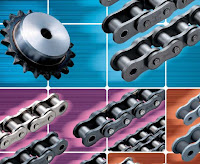Chain Drives Design (Part 1)
 Chain drives are used to transmit rotational motion and torque from one shaft to another, smoothly, quietly and inexpensively. Chain drives provide the flexibility of a belt drive with the positive engagement like a gear drive. Therefore, the chain drives are suitable for applications with large distances between shafts, slow speed and high torque.
Chain drives are used to transmit rotational motion and torque from one shaft to another, smoothly, quietly and inexpensively. Chain drives provide the flexibility of a belt drive with the positive engagement like a gear drive. Therefore, the chain drives are suitable for applications with large distances between shafts, slow speed and high torque.Usually, chain is an economical part of power transmission machines for low speeds and large loads. However, it is also possible to use chain in high-speed conditions like automobile engine camshaft drives. This is accomplished by devising a method of operation and lubrication.
Compare to other forms of power transmission, chain drives have the following advantages:
- Chain drives have flexible shaft center distance, whereas gear drives are restricted. The greater the shaft center distance, the more practical the use of chain and belt, rather than gears. Chain can accommodate long shaft-center distances (less than 4 m), and is more versatile.
- Chain drives require little adjustment, whereas belts require frequent adjustment.
- Chain drives are less expensive than gear drives.
- Chain drives have no slippage, as with belts, and provide a more efficient power transmission.
- Chain drives are more effective at lower speeds than belts.
- Chain drives have lower loads on the shaft bearings because initial tension is not required as with belts.
- Chain drives have longer life service life and do not deteriorate with factors such as heat, oil, or age, as do belts. Sprockets are subject to less wear than gears because sprockets distribute the loading over their many teeth.
- The sprocket diameter for a chain system may be smaller than a belt pulley, while transmitting the same torque.
- Chain has a speed variation, called chordal action, which is caused by the polygonal effect of the sprockets.
- Chain needs lubrication.
- Chain wears and elongates.
- Chain is weak when subjected to loads from the side. It needs proper alignment.
The followings are some example of chains from British and ISO standard.
BRITISH STANDARD ROLLER CHAINS
BS 228, ISO R606, DIN 8187
ISO Chain no.
The first two digits are related to the chain pitch. See below table.
Source:
- http://www.fptgroup.com/Chain/
- Machines and Mechanisms Applied Kinematic Analysis, 3rd edition, David H. Myszka
- http://chain-guide.com *** Recommended web site for chain drives.
- http://tsubakimoto.com/product/drive-chains/lube-free/lube-free/class3/10/2/2/





Comments